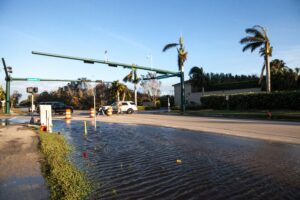
Now that the 2022 hurricane season is over, rebuilding is underway. Because of its intensity and where it made landfall, Hurricane Ian was the costliest weather event in Florida’s history. Naturally people want to rebuild and get on with their lives. But it’s worth asking whether that would just be a matter of continuing to do the same thing and expecting the results to be different. How can individuals and communities build in resilience? That is, how can we make sure that rebuilding doesn’t just set us up for another catastrophe?
Now, in the wake of the Category 4 hurricane, state and local leaders have promised to rebuild. Stronger building codes like the kind created after 1992’s Hurricane Andrew will make the area more resilient to future storms, they say. But climate and planning experts warn that rebuilding along the crowded coast, following a decade of weakened rules governing development, is what helped create the disaster now unfolding. Specifically, they point to Florida’s decision in 2011 to abolish the state agency that managed risky development even as threats from climate change deepened.—NPR 8 October 2022
Managing growth in Florida
In planning for resilient infrastructure, government plays a vital role. Governments adopt and enforce building codes. Local regulations can limit paving or keep people from building in low-lying areas. But state or regional regulations may be necessary to protect larger areas or plan major infrastructure. For example, highways are essential in evacuating people ahead of wildfires or hurricanes, and in providing emergency assistance afterwards.
…[T]he market does not incorporate environmental externalities very well. An ecosystem…is not local. An ecosystem is broader, and in the state of Florida we have ecosystems that take up hundreds and thousands of square miles. And there is no way a local community is going to incorporate all of that thought into development of planning processes when it is in juxtaposition to economic concerns.—Estelle Robichaux, testimony to Florida state senate in support of the Department of Community Affairs
Beginning in the 1970s, “developments of regional impact” were subject to state review. In addition, the state had direct oversight of development in “areas of critical state concern” such as the Everglades. In these cases the state could override local government decisions that failed to consider the broader effects of development. The bipartisan Environmental Land Management Study Committee incorporated both public- and private-sector representatives having a range of interests.
In 1986 Florida established a Department of Community Affairs. Its purpose was to ensure that local growth plans did not allow development to harm water supplies, and that schools, roads, hospitals, and other infrastructure were adequate to handle the population increase. By then Florida’s rapid population growth had demonstrated that without regulation, growth would not pay for itself. County- and municipal growth plans had to conform to the state’s comprehensive growth plan. Local governments also had to provide for low- and moderate-income housing.
The Great Recession
Despite legal challenges and economic ups and downs, these reforms continued through nearly two decades and four gubernatorial administrations. By the late 1990s, rapid population growth had made urban sprawl apparent, and public school facilities weren’t keeping up. Further modifications addressed these concerns, along with water quality.
Then came the Great Recession, which hit Florida especially hard. People came to view state regulation of growth management as an impediment to economic recovery. Growth management began to give way to economic development. In 2009 the state legislature began to exempt some projects from state review, eroding requirements for transportation infrastructure capacity. In addition, many jurisdictions no longer had to submit projects to review for developments of regional impact. Despite pushback from some cities, more change was soon to come.
In 2011 the Florida legislature rewrote the state planning act, shrinking the size and purview of the Department of Community Affairs. Rick Scott, the new governor, had campaigned on a platform of eliminating excess regulation. He specifically targeted the Department of Community Affairs as a “jobs killer”. The Community Planning Act of 2011 restricted state- and regional review authority and no longer required local development plans to be consistent with the state plan. Local authorities could decide for themselves whether to ensure that transportation, schools, and parks would be adequate for population growth. In addition, certain projects such as mines, industry, hotels, and movie theaters were now exempt from state review.
Is rebuilding always good?
Eleven years after the Community Planning Act of 2011, Florida was more vulnerable to a major weather event. Sanibel Island showed what happens when there’s only one access route: if the bridge collapses, there’s no way in or out. Flooding is more severe when paving and housing replace natural defenses such as mangrove swamps. And damage costs more when more people and more development lie in the pathway of a storm.
Florida beefed up its building code following Hurricane Andrew in 1992, making buildings safer. Hurricane Ian should prompt a similar reconsideration of growth management. Government regulation isn’t all bad. It can even save lives.
